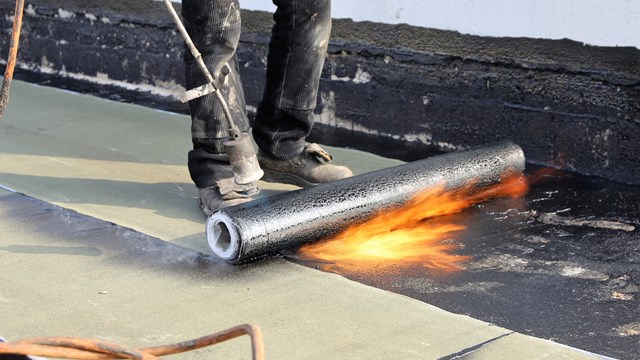New York City's skyline wouldn't be the same without its rooftop water tanks. The strange-looking structures have graced the cityscape for more than a century, and today, surrounded as many of them are by towering glass skyscrapers, they seem anachronistic. They may hearken back to an older time, but the city's water tanks aren't just for decoration; they're still very much in use.
According to Scott Hochhauser, an owner of Isseks Bros., a century-old company in Manhattan that specializes in water tank repair and maintenance, most buildings with more than six floors use a water tank as their water source."As you start going above [six floors] the water pressure decreases because you're going higher. That's why you need a tank."
According to Hochhauser, his great-grandfather Abraham Isseks invented the water tank after the mechanical elevator became more and more widely used in New York City and buildings started to get taller.
"My great-grandfather was a barrel maker and he said, "˜This is something that is going to be needed as they make more and more of these tall buildings,' says Hochhauser. "So in 1890, they started this company to put water tanks on roofs."
Meet Your Tank
Suprisingly, most tanks used for residential buildings are made of wood - cedar, to be exact. According to Andy Rosenwach, president of Rosenwach Tank Co., Inc., "In today's world, 90 percent of roof tanks are made of western cedar. Some residential buildings have metal tanks made out of carbon steel or stainless steel, but steel tanks don't hold heat as well as the wood tanks do. Therefore, you see steel mostly indoors. And the wood tanks have a very good [insulation quality]. The nominal three-inch lumber that's used is equivalent to 24 inches of concrete in terms of insulation. In the summer, when the heat is on top of the tank, wood will keep the water cooler than steel will.
And that cooler water has a purpose, says Hochhauser. Residents use it for a variety of things, from drinking to cooking to showering - and they also are used if the building ever has a fire.
"The bottom of the tanks is a reserve," says Hochhauser. "The water sits there for the standpipe in case there's a fire. The top of the tank is generally for domestic water. As people use that water, it drops down to a certain level, and there's a switch in the tank that's connected to the pump in the basement. The switch tells the pump to turn on and replenish the tank." Hochhauser adds that only the levels of the domestic water change with water usage. The water in the fire reserve is always there - unless there's a fire, of course.
Water is pumped into the tank from the main water source below the streets. "The water comes into the building through the underground city main," says Steve Silver of American Pipe & Tank Lining Co. "In the basement, there is typically one or two pumps that pump the water up into the roof tank. The roof tank is really nothing more than a holding reservoir. It's then distributed throughout the building by means of gravity."
Tanks come in various sizes, depending on the size of the building it is serving. Hochhauser says an average residential building would utilize a tank that can hold about 8,000 to 12,000 gallons.
Silver says tank companies don't typically determine the size a tank will be. That's done by the engineers who design a building and then order the tank. When a tank needs to be replaced, the company will replace it with a similar one.
Cleaning and Maintenance
Buildings have a responsibility to keep their tank in proper condition.
"New York City building code requires than any tank [containing] drinking water be cleaned and disinfected once a year," Silver says. "When we go [to do a maintenance call], the building typically drains the tank ahead of time. We get in the tank, we scrub it down and flush out all the sediment and rust that has built in the system over the last year since it was cleaned. The inside of the tank is scrubbed down with a hypochlorine solution which kills any bacteria or algae that has grown over the last year." The process will result in the building being without water for about half a day.
"Generally," adds Rosenwach, "the tank should be examined for wear and tear on the cover, which is a component that will keep the tank free of birds and debris. The structure should be visualized for painting and steel deterioration. The pipe covering should be reviewed so that [it] stays intact, and the electrical system should be checked."
Hochhauser says that while the crew is cleaning the tank, they will also tighten the tank's hoops and caulk leaks.
"You shorten the life of a tank by not taking care of minor problems - like small leaks, for example - before they become major problems," Hochhauser says. "If the tank is cleaned and maintained once a year, you can prevent overflows, which can cause a lot of damage to the building. You can also prevent leaks that cause icicles, which can drop and cause a lot of damage to the building." He adds that he's seen icicles as big as 12 feet dangling from roofs.
Your tank maintenance company will perform the inspection and provide you with a certificate that the inspection was done. The city isn't likely to inspect your tank, but it may come around and ask for records of the tank's cleaning and maintenance history.
You can expect a tank to last 20 to 25 years. Silver says the wood will eventually decay to the point that it become porous and water will leak through the lumber.
But your company should be able to give you a head's-up about its condition after a few years. "We do that for our customers," Silver says. "That way, they can budget that money so it doesn't come as a surprise."
"We send out a reminder that we're available to look at them and service the tank on a yearly basis," says Rosenwach of his company's procedure. "[We ask for] permission to look at the tank and clean it if we've done it before."
It's difficult to pinpoint exactly what a new tank will cost. That's largely due to the fact that it isn't tank size alone that determines the cost. How the tank will get to the roof is also a factor.
"You can have the same 10,000-gallon tank cost two different amounts in two different buildings," says Silver. "In one building, the elevator might be small and the stairway tight, so the new tank materials have to be hoisted to the roof as opposed to being delivered through a freight elevator," Silver says. "This adds to the expense - sidewalk, permit, those kind of things."
Tank cleanings and installations are done year round, though the appointment could be postponed if there are extreme weather conditions.
Monthly Inspections
Of course, self-relaiant as they are, roof tanks aren't immune to invasion. A bit of nasty business can occur in the form of leaves, dirt, and even animals and other pollutants getting into the tank area, which can lead to drinking water getting dirty.
"Imagine the tank as a barrel with an open top," Silver says. "We cover the open top with a flat cover, and then a cone-shaped cover - what we call a conical cover - is constructed on top of that. That's meant to protect the pump control switches that are mounted to the flat cover itself. That conical cover is the first line of defense against weather, pigeons, airborne dirt and contaminants. Once that conical cover is compromised and there are openings in it, whether a windstorm rips off a piece or it just naturally deteriorates, the pigeons make it a home. It has shelter and access to water, so it's a perfect roosting location for pigeons."
Silver says he's seen mice and rats as well as bird eggs and dead birds under conical tank covers. The problem is that when it rains, the rain filters over, under, and through any debris, soiled nesting material, or carcasses under the cover, then into the building's water supply as runoff. To minimize this ickiness, Silver says buildings are required to do a monthly inspection.
"The super should be checking to make sure the conical cover is in good condition and that it is tight so that no birds or debris or contaminants can get into it." If damage is discovered, contact your water tank maintenance personnel immediately. Silver says that too often, monthly inspections are not done and a somewhat unpleasant - or unhealthy - situation isn't discovered until the annual inspection.
Silver says that during the winter months, it's important to make sure the insulation in the tank piping is in good condition.
"This winter, with the drastic temperatures we've had, we've experienced a lot of freeze-ups where the water tank piping is not properly insulated or the insulation is old or deteriorated," he says. "Or maybe there are sections that are just missing and nobody in the building did anything about it. Unfortunately, that's something that typically costs many thousands of dollars to repair and re-insulate. And then you have to contend with water damage in the building itself."
New Tank Tech
Today's tanks, though still made of wood and held together with bolts and steel bands, are benefitting from the introduction of some new-and-improved tank technology. "We're now working with and selling an embedded micro-processing system which will allow us to monitor the tank," says Rosenwach, "and also the two-wire system; low voltage for high/low indication per foot of height.
"Normally," Rosenwach continues, "the tanks are based on a float system. Now we're going to be eliminating all these floats and all these wires and handling all functions with two wires and one signal device. It's a dual-pump system in which a second pump will kick in if one pump can't keep up with the supply. The device will also monitor security of water supply; and call up to a beeper, cell phone, or the lobby if there is a problem with any of the monitoring of water levels or temperatures. The system will also record history of data to be centrally monitored from our station as an additional feature. Also, with the push of a button, a device will be able to review [the history] in different languages."
The New York City skyline just wouldn't look the same without its rooftop garland of rustic wooden water tanks. If your building is tall enough to have a tank, make sure it's well cared for and properly maintained. Roof tanks aren't just interesting architectural conversation pieces; they're working parts of your building's operating systems and deserve some tender loving care on a regular basis.
Anthony Stoeckert is a freelance writer and







Leave a Comment